Key takeaways:
- Selective mutism is an anxiety disorder where children can speak in some settings but struggle to communicate in others, often leading to misunderstandings about their behavior.
- Raising awareness and promoting understanding of selective mutism can create supportive environments that encourage communication without pressure.
- Utilizing non-verbal communication methods, such as art or visual aids, can effectively help children express themselves and build connections.
- Personal stories and community acceptance can empower children with selective mutism, highlighting the importance of recognition and validation in their experiences.
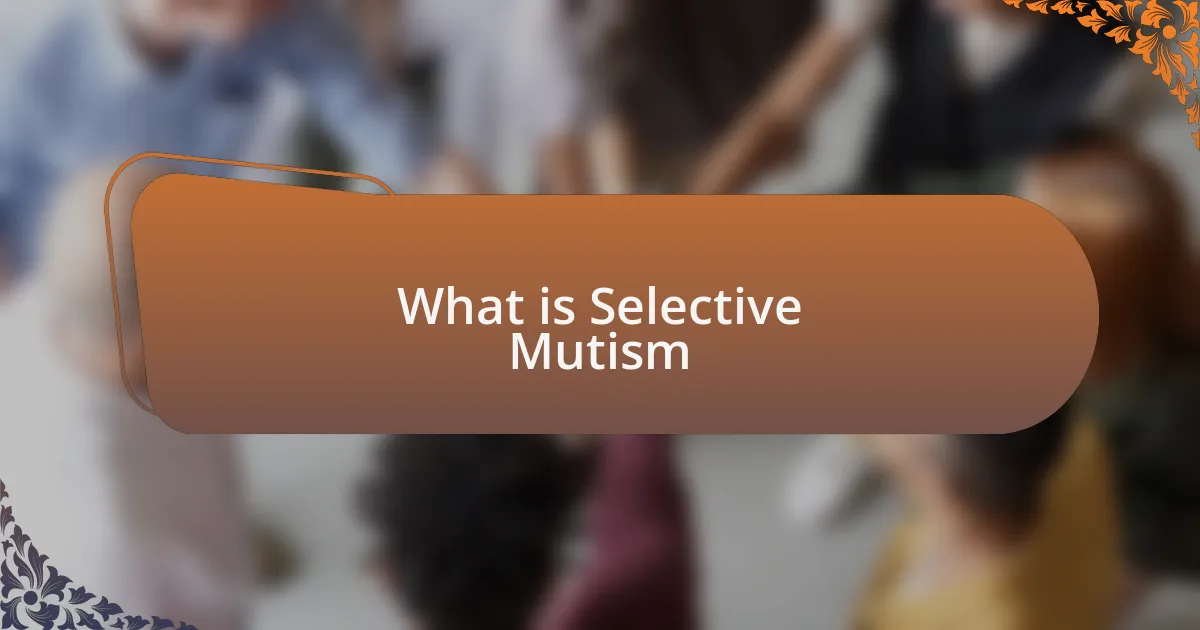
What is Selective Mutism
Selective Mutism is a complex anxiety disorder primarily affecting children, characterized by the inability to speak in certain social situations despite being capable of verbal communication in other settings, like at home. I remember a friend of mine sharing her experience with her son, who would engage in animated conversations at home but fell silent in the school environment. It’s perplexing, isn’t it? How can a child who chats so freely at home suddenly become mute in public?
Essentially, selective mutism isn’t a choice; rather, it stems from overwhelming anxiety or fear that grips the individual in specific social interactions. It can feel heartbreaking to witness a child who wants to express themselves but feels trapped by their anxiety. When I first learned about it, I couldn’t help but wonder why society often misunderstands these children as simply shy or rude when, in reality, they may be grappling with intense emotional struggles.
Moreover, the silence associated with selective mutism can lead to a range of emotional ramifications, both for the child and their families. The disconnect between their inner thoughts and external expressions can create feelings of isolation, not just for the child, but also for parents who wish to support them. Have you ever seen someone struggle to communicate? It’s as if there’s a bridge between two worlds that desperately needs building.
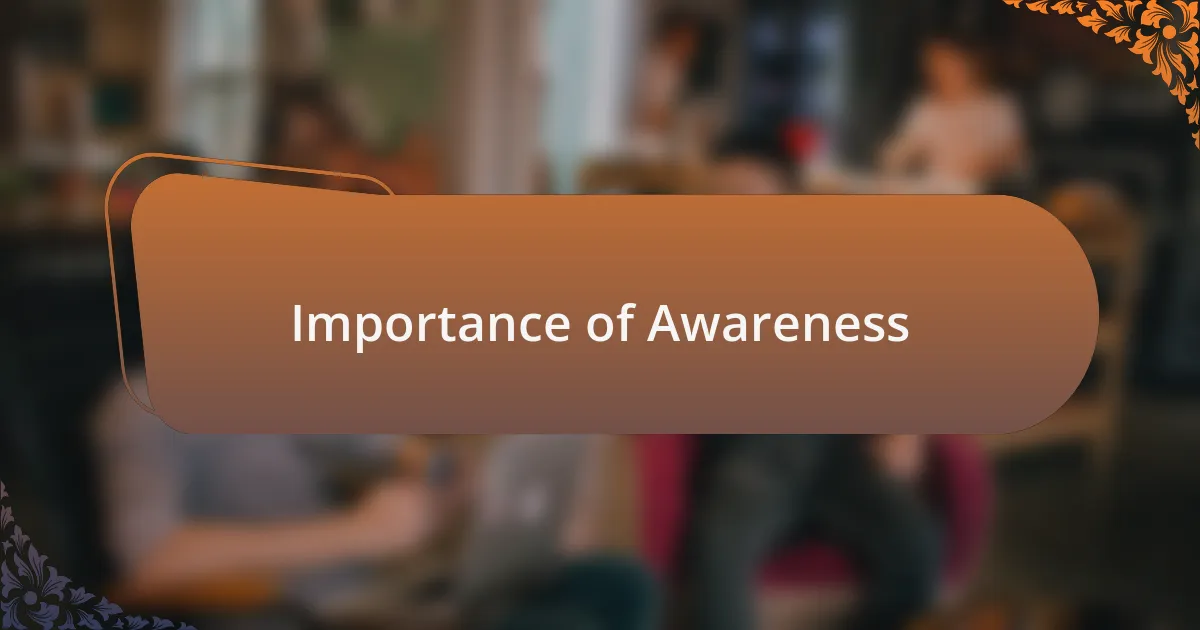
Importance of Awareness
Awareness of selective mutism is crucial because it tackles the misconceptions that surround this condition. I recall a workshop I attended where a parent bravely shared stories of moments where her child’s silence was mistaken for a lack of intelligence or interest. Hearing these experiences made me realize how empathy can dissolve judgment; it’s essential to understand that silence often signals deep-seated anxiety, not a rejection of social interaction.
By promoting awareness, we empower not only children with selective mutism but also their families and educators. One time, I witnessed a teacher approaching a mute child with kinder comprehension; instead of pressing for verbal responses, she created a safe space for him to express his thoughts through drawings. This shift in perception illustrates how awareness can lead to more supportive environments that foster communication without added pressure.
Furthermore, heightened awareness can break down the stigma surrounding anxiety disorders in general. I often think about the friends I’ve seen rally around a child struggling with selective mutism, showing patience and understanding instead of frustration. Such collective compassion can create a ripple effect, encouraging a more inclusive atmosphere where everyone feels valued and understood, regardless of their ability to communicate.
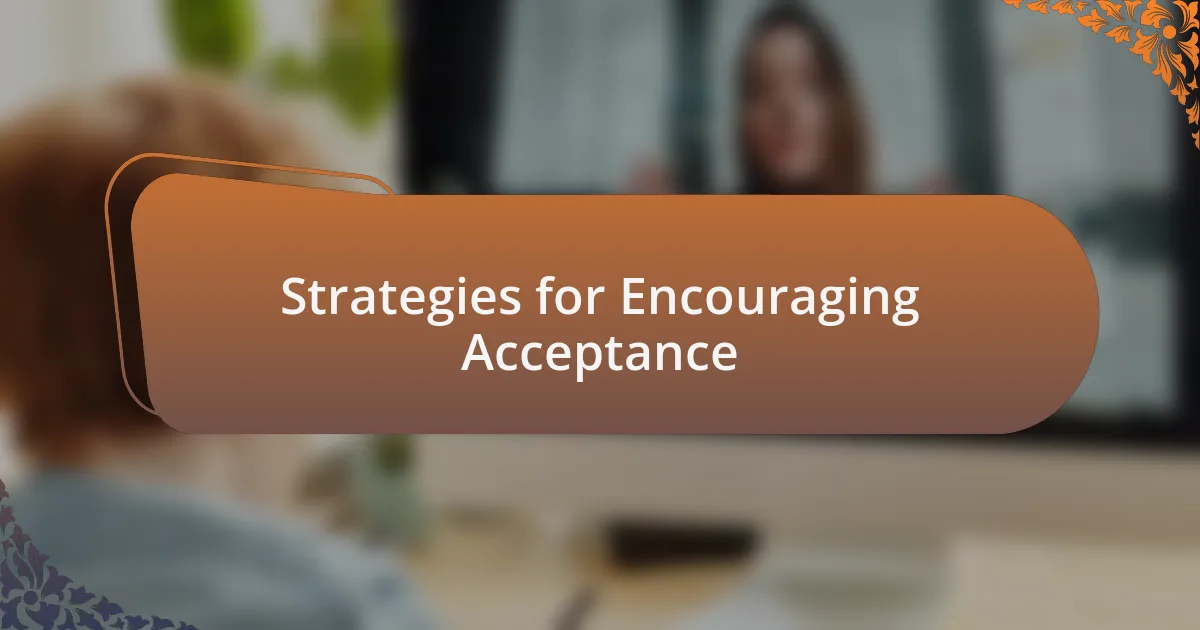
Strategies for Encouraging Acceptance
One effective strategy for encouraging acceptance is fostering open dialogue in schools and community settings. I remember a school assembly where a counselor spoke candidly about selective mutism, sharing relatable stories that helped demystify the condition. Seeing students nodding in understanding made me realize how openly discussing these topics can cultivate empathy and reduce stigma.
Another approach is to involve peers in activities that promote connection without the pressure of speaking. For instance, during a group art project I participated in, the members who struggled with verbal expression thrived in non-verbal ways, sharing their ideas visually. It was heartwarming to watch as friendships blossomed in these moments, highlighting that communication goes far beyond words.
Lastly, modeling patience and understanding in everyday interactions can create a culture of acceptance. One day, I overheard a parent gently explain to a curious child why their friend didn’t speak much. The parent’s calm demeanor and clear explanation helped the child grasp the concept, sparking a deeper inquiry into the feelings we all experience. Don’t we all deserve a little compassion and patience as we navigate our unique journeys?
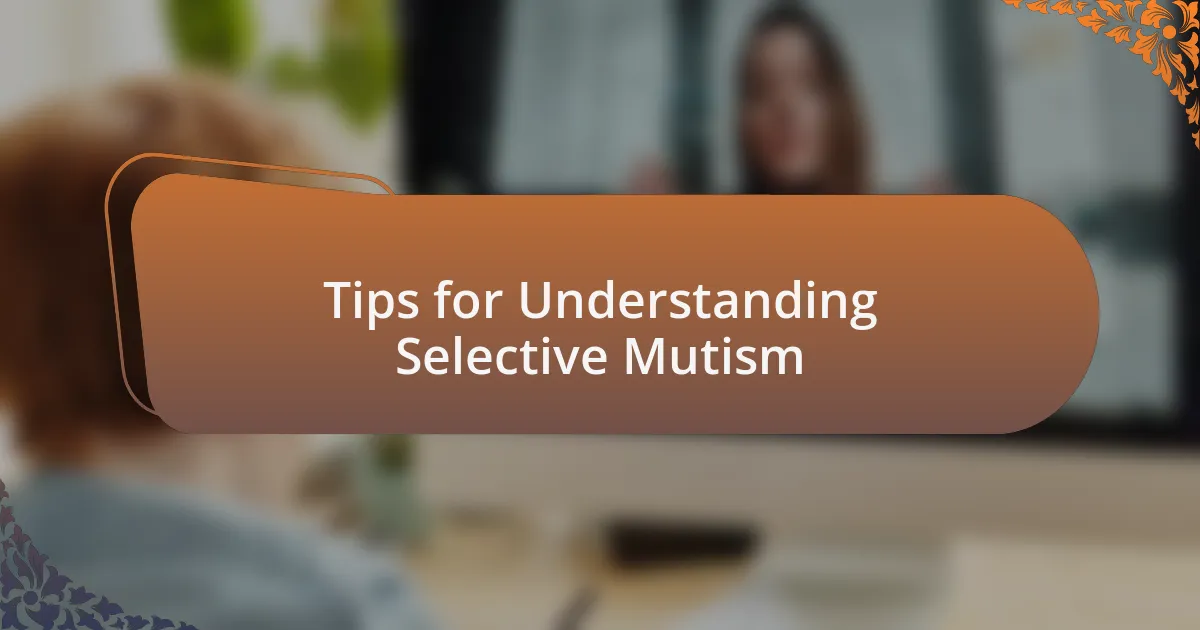
Tips for Understanding Selective Mutism
Understanding selective mutism requires patience and an open heart. I recall a situation where I volunteered at a community center. A child with selective mutism sat quietly as others played, and it struck me how easily people can overlook the silent struggles. The lesson here? Sometimes, simply being present speaks volumes more than words ever could.
Another tip is to educate yourself and others about the challenges faced by individuals with selective mutism. I remember sharing resources with friends, which sparked meaningful discussions. It made me realize how enlightening a simple article or video can be in unraveling misconceptions and fostering compassion. Have you ever had a conversation that shifted your perspective? It’s amazing how knowledge can build bridges of understanding.
Lastly, consider providing safe spaces where children can express themselves at their own pace. I once saw a workshop where participants could write letters instead of speaking. The relief on their faces was palpable; it was an effective reminder that communication is multifaceted. Why should we limit our understanding of connection to just spoken words? There are countless ways to relate to one another that celebrate our differences.
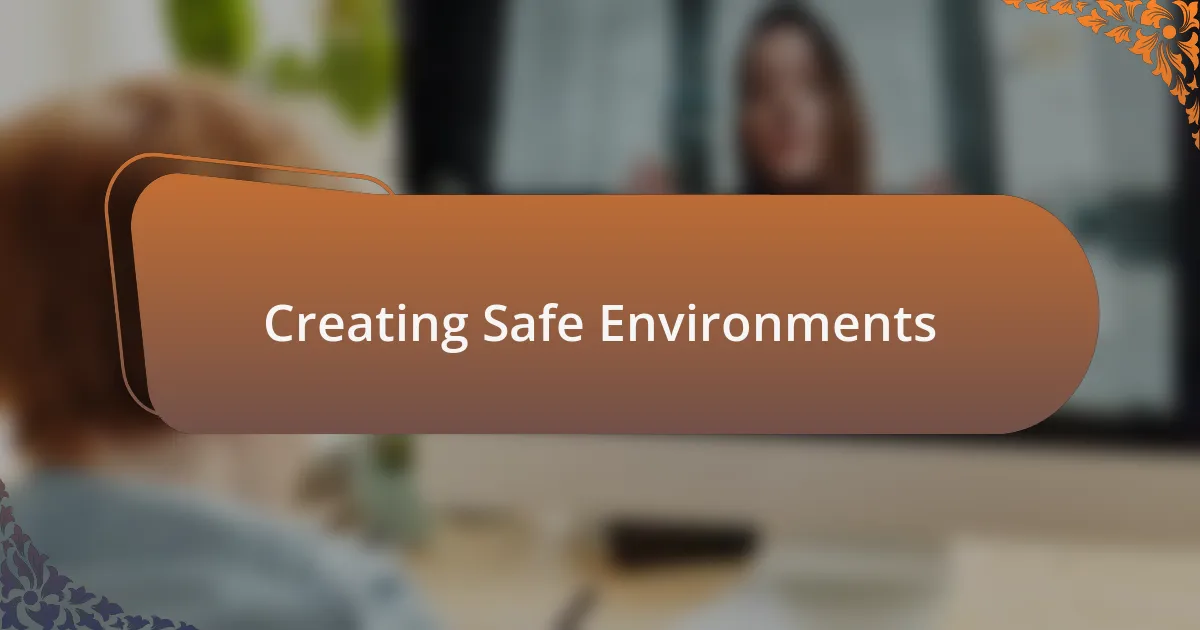
Creating Safe Environments
Creating a safe environment starts with the recognition that silence isn’t just absence of speech; it can be a profound form of communication. I remember a cozy nook in a library where I observed a child with selective mutism curled up with a book, completely at ease. It dawned on me then that creating a welcoming space—free from judgment—can invite those who struggle to find their voice. Have you ever felt more comfortable in a corner of peace rather than a loud, bustling crowd?
Additionally, I’ve found that encouraging non-verbal interactions can transform the way children connect. One memorable afternoon, I facilitated a drawing activity, allowing kids to express their feelings through art rather than words. Watching their creativity flow without pressure was moving, and it underscored the importance of offering various avenues for expression. Isn’t it incredible how a simple crayon can unlock so much emotion?
Ultimately, setting clear communication guidelines can also make a significant difference. In a group I participated in, we adopted a ‘no pressure’ rule—don’t force anyone to speak. Just knowing that they weren’t expected to talk eased the tension in the room. I often wondered how many voices would bloom if we embraced this principle more widely. When participants feel secure, they often surprise us with their insights, ready to share their world in ways we might not have anticipated.
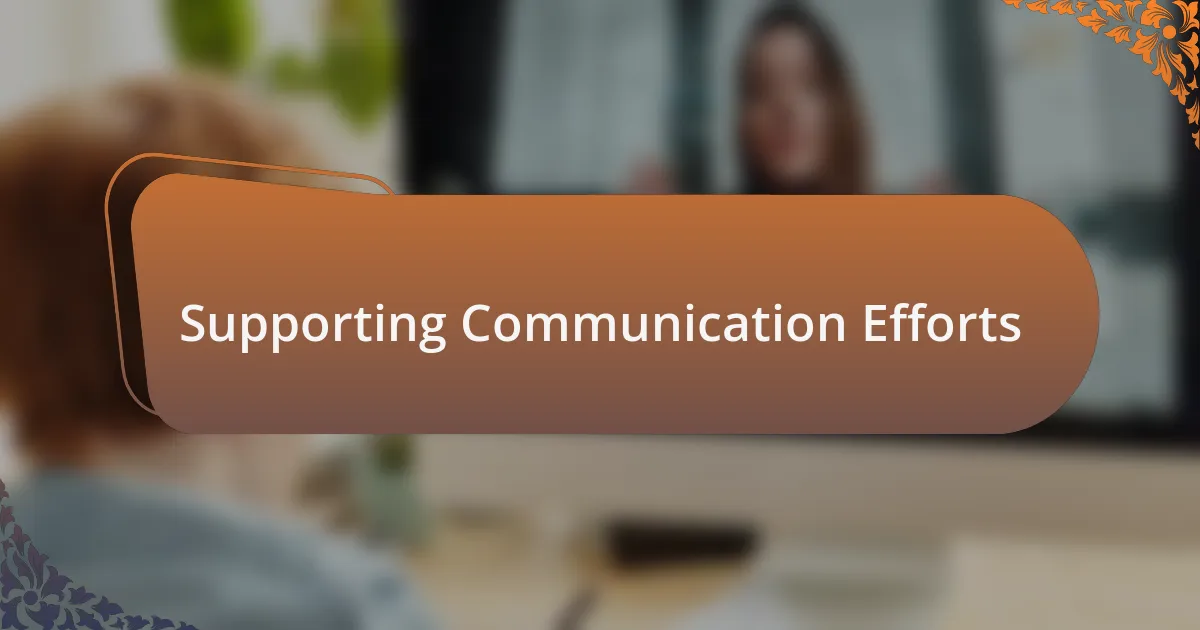
Supporting Communication Efforts
Supporting communication efforts requires a multifaceted approach that recognizes the unique challenges faced by those with selective mutism. I’ll never forget a workshop where we tried using puppets to encourage dialogue among children. The moment a shy little girl watched her puppet ‘talk’ and then decided to whisper back was magical. It made me realize that sometimes, breaking the ice with a playful prop can lead to heartfelt expression. Have you ever noticed how a fun activity can loosen the tight grip of anxiety?
Utilizing visual aids has proven beneficial as well. On one occasion, I created a ‘communication board’ filled with images that children could point to, bypassing verbal barriers entirely. The joy in their eyes when they realized they had a way to share their needs was unforgettable. It’s a testament to how empowering visual tools can be: they transform communication into a tangible experience.
Moreover, fostering peer support can catalyze progress. In one of my groups, pairing children with supportive friends encouraged a sense of safety and camaraderie. I remember a boy who would only speak to his best friend, and witnessing their interactions made it clear that connections matter. Isn’t it fascinating how a trusting relationship can encourage someone to find their voice?
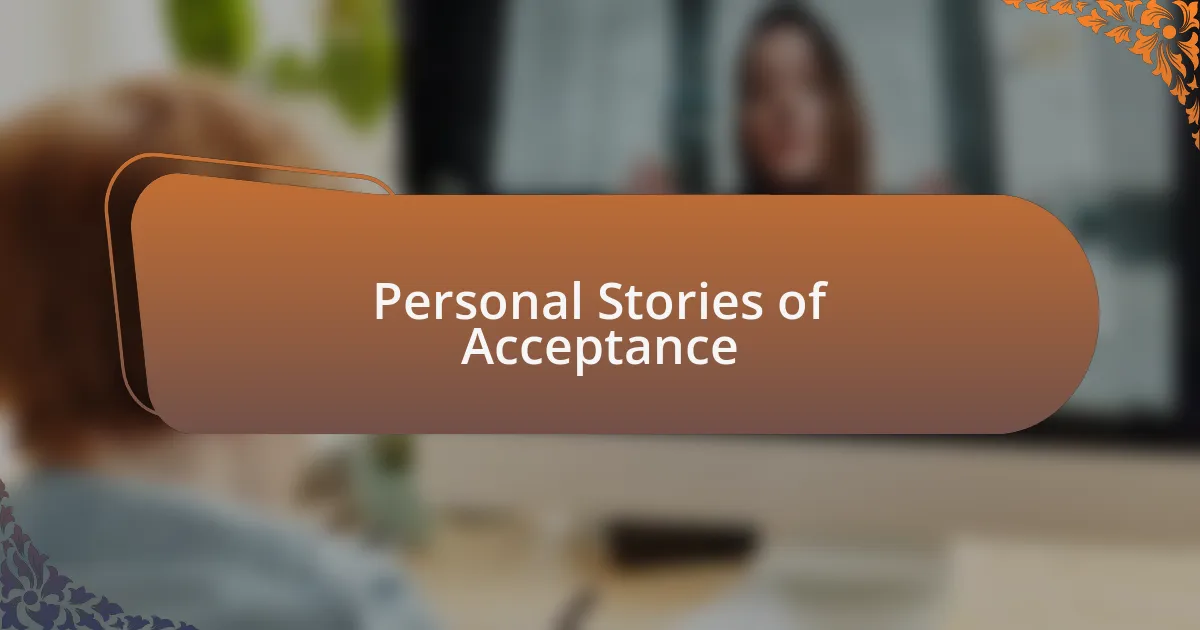
Personal Stories of Acceptance
I recall a poignant moment during a school presentation where a boy with selective mutism stood silently at the front, his heart racing. After a supportive teacher encouraged him, he finally took a deep breath and shared his favorite book. The applause that followed was not merely supportive; it was an affirmation of acceptance that filled the room with warmth. Have you ever experienced how validation can spark courage in someone?
There was an instance when a community organized a ‘silent day’ where everyone communicated through gestures and drawings. One young girl, who often struggled to speak, thrived that day. Her vibrant illustrations told stories of her world, showcasing that acceptance isn’t about urging someone to speak but about welcoming their unique form of expression. Doesn’t it strike you how creativity can be a bridge to understanding?
I also think of a parent in my support group who shared how their child began to express themselves through music. The first time they performed in front of family, the pride glowing on their face was unmatched. Acceptance isn’t always verbal; sometimes it’s found in the rhythms and notes that capture the essence of who we are. Have you ever considered how profound personal expression can be in forging connections?